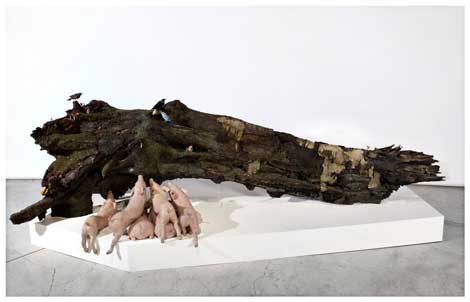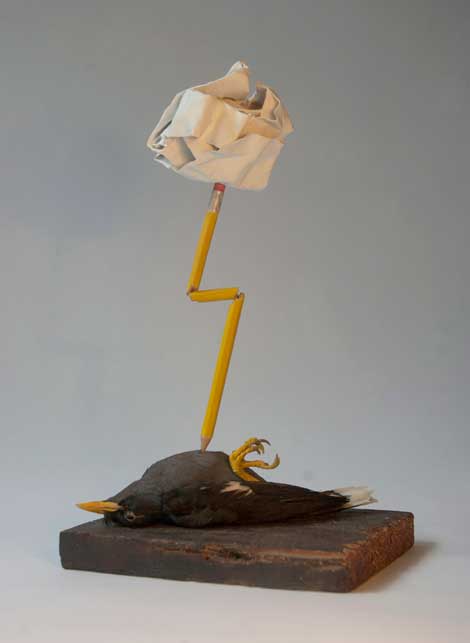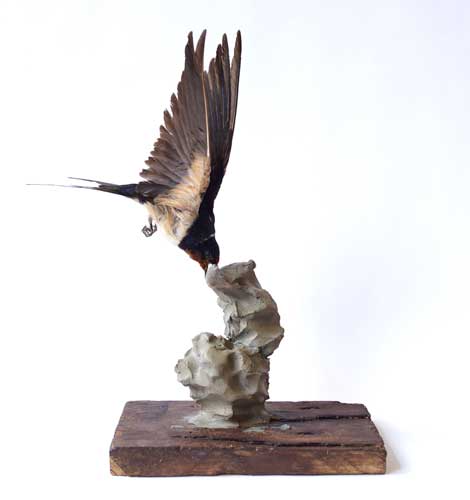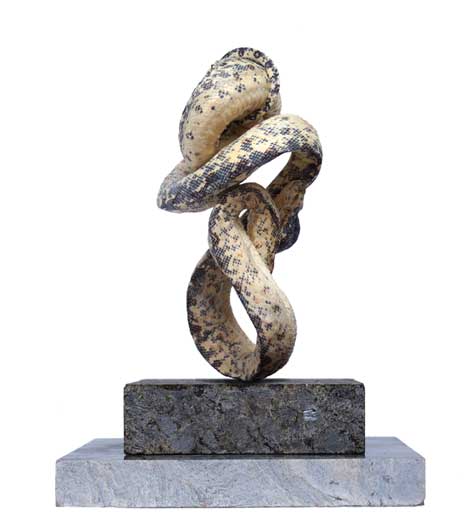There are artists for whom the process of making art has become primarily a lucrative business: the brands of Jeff Koons and Damien Hirst come to mind. Collectors and galleries make demands for signature work, and artists may reach a certain point where they delegate duties to a team of fabricators and assistants. Through the ages, artists have always had assistants. Michelangelo probably gave the boring bits of the Sistine Chapel to his underlings. But he still got his hands dirty.
Today, Polly Morgan is one of London’s hottest young artists. Her coltish figure can be found on the who’s who pages of glossy magazines snapped, say, at a Jimmy Choo fashion show with her partner, the artist Mat Collishaw. But visit her in her East London studio, part of an old industrial complex, and the person you’ll meet is very different: modest and down to earth.
Morgan never went to art school. In 1998, she moved to East London to read English literature. As an undergraduate working in a bar, she became acquainted with many of the prominent artists that hung out in the area. Encouraged by their success, she decided to make work using animals as her subjects. She took up taxidermy and studied with the Scottish taxidermist George Jamieson, slowly subverting the craft’s traditions to create finely-wrought, often surreal sculptures that brought her work to the attention of collectors and curators both in Britain and internationally.
A country upbringing meant that she took animals for granted. She grew up with a bestiary of goats and llamas, dogs and stray pigeons. Her work respects the animals she uses and introduces them to the viewer in a new light. Ever since the London restaurant Bistrotheque commissioned a piece, she has exhibited her work widely.
So what is her working practice? Does she use assistants? In 2004 when she first started showing, she received a number of applications from interns who visited her website. She accepted a couple but says she was not very good at harnessing what they had to offer. Then along came Kim Wagner, who was prepared to do anything and everything. In 2009, when Morgan was working on the rather Gothic piece, Carrion, with its multiple chicks bursting from a coffin, Wagner helped prepare the birds. Soon she became highly accomplished at the craft of taxidermy. But her relationship with Morgan worked because she sees herself primarily as a technician rather than a fellow artist.
Apart from the financial drain of having a permanent assistant, Morgan admits that if all her work was made by fabricators, she’d miss the very thing that drew her to become an artist in the first place—the tactile visceral quality of making things. “I’d be frustrated simply giving instructions to others and watching them make what I wanted to make,” she says. “For me, the challenge is always to come up with a concept worth following through and developing. That done, the making is the enjoyable bit when I can relax. At the beginning of my career my work was more instinctive, more hit and miss, but now everything is meticulously planned and drawn to scale with a computerized 3D modeling program called SketchUp.”
While preparing for “Psychopomps,” her show at Haunch of Venison in 2010, she had about five interns working in the studio. Never having worked in an office she enjoyed the camaraderie. She taught them how to take the wings off birds, to de-flesh the bone, then de-fat the skin to be ready for use. A natural loner, she enjoyed the experience of working in a busy studio for short bursts.
But Morgan can’t ever see herself working as a project manager and not actually making the work herself. When I visited, she was casting a tree snake in silicon. She wants to move away from graphic and descriptive pieces to explore more minimal forms and abstract shapes. Her work is becoming more sculptural, more concerned with how forms inhabit space. But stretching snake skin over silicon to the standard she requires is very hard without a great deal of messy cutting and sewing. It’s all a question of trial and error.
Ironically, she admits that she wouldn’t really want to own many of her pieces. Her own aesthetic is much sparer. She admires the sculptures and drawings of Tim Noble of Webster and Noble and the recent bronze sculptures by Sarah Lucas. But she is a hands-on artist who likes to sit quietly constructing a piece. Assistants are all very well for going to the post and helping with the stuff that gets in the way of the actual work. But I don’t think there will be a brand of Polly Morgan any time soon.
See Morgan’s work at Nevada Art Museum, “Late Harvest” in Reno. September 27, 2014–January 18, 2015; nevadaart.org





